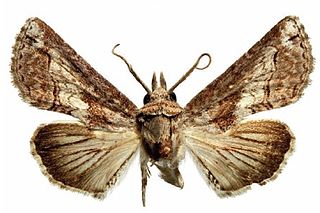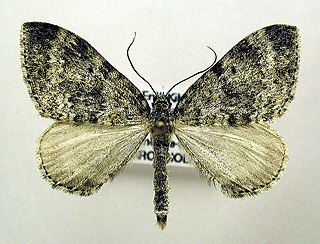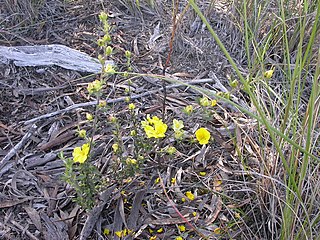
Pollanisus apicalis is a moth of the family Zygaenidae. It is found in the eastern part of Australia.

Anachloris subochraria is a species of moth of the Geometridae family. It is found in New Zealand and the southern half of Australia including Tasmania and from Queensland across to Western Australia.

Zale is a genus of moths in the family Erebidae erected by Jacob Hübner in 1818.

Delgamma is a monotypic moth genus of the family Noctuidae erected by Frederic Moore in 1885. Its only species, Delgamma pangonia, the strawberry cutworm, was first described by Achille Guenée in 1852.

Anachloris is a genus of moth in the family Geometridae, with 3 species, found in Australia, New Zealand and Papua New Guinea.
Euphyia is a genus of moth in the family Geometridae.

Euphyia intermediata, the sharp-angled carpet, is a moth of the Geometridae family. It is found from coast-to-coast in southern Canada and the northern United States, south in the east to North Carolina, south in the west to California, Utah, and possibly Arizona. It is also found north to the Northwest Territories and Alaska.

Amyna axis, the eight-spot, is a moth of the family Erebidae. The species was first described by Achille Guenée in 1852.

Pollanisus viridipulverulenta, the satin-green forester, is a moth of the family Zygaenidae. It is found in the eastern part of Australia.
Pollanisus nielseni is a moth of the family Zygaenidae. It inhabits the Australian state of Western Australia, mostly coastal areas, and has brilliantly shiny forewings. The diurnal adults are most active on sunny days. Eggs are laid on the plant Hibbertia spicata, and females touch each egg after oviposition with a tuft of hair on their abdomen, which attaches protective spines. The larvae are brightly coloured and feed on H. spicata before pupation.
Pollanisus empyrea is a moth of the family Zygaenidae. It is endemic to the temperate parts of the Australian state of Western Australia.
Pollanisus trimacula is a moth of the family Zygaenidae. It is found in Australia in south-eastern Queensland and eastern parts of New South Wales.
Buciara bipartita is a moth of the Noctuidae family. It is found in the Australian Capital Territory, New South Wales, South Australia and Victoria.

Euteliidae is a family of moths in the superfamily Noctuoidea.

The yellow-ringed carpet is a moth of the family Geometridae. It is found in the mountainous areas of the Palearctic ecozone The distribution is disjunct extending across the Pyrenees, the Alps, some lower mountains and then from Norway across the Arctic to northern Russia.

Hibbertia fasciculata, is a small shrub that is endemic to south-eastern Australia. It grows to 40 cm tall and has clusters of narrow leaves that are 4 to 6 mm long and about 0.5 mm wide. Yellow flowers appear from winter to early summer.

Melaleuca uncinata, commonly known as broombush, broom honeymyrtle or brushwood, is a plant in the paperbark family native to southern Australia. It is harvested from the wild, and grown in plantations, for broombush fencing. The Noongar names for the plant are kwytyat and yilbarra.

The grey carpet is a moth of the family Geometridae. It is found in most of Europe, from Great Britain and the Iberian Peninsula to the Ural Mountains and further east to central Asia and Transcaucasia, Asia Minor and the Near East.

Hambidge Wilderness Protection Area is a protected area in the Australian state of South Australia located in the gazetted locality of Hambidge about 140 kilometres north of Port Lincoln and 15 kilometres north east of Lock.
















